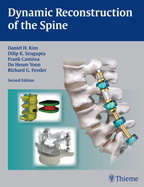|
|
|
| |
 |
|
|

|
 推薦指數:
推薦指數:





|
|
- 內容介紹
|
Dynamic Reconstruction of the Spine 2nd Edition
by Daniel H. Kim (Editor), Frank P Cammisa (Editor), Richard Glenn Fessler (Editor), Dilip K Sengupta (Editor), Do Heum Yoon (Editor)
Hardcover: 480 pages
Publisher: Thieme; 2 edition (June 5, 2015)
Language: English
ISBN-10: 1604068736
ISBN-13: 978-1604068733
Review
The editors have succeeded in producing a text that provides a complete and up-to-date reference on the current state of dynamic stabilization, as well as on the technologies that are currently present only in the laboratory or are in the process of transitioning to the clinical realm. ...A very useful text for any clinician who actively treats degenerative disorders of the spine.--Journal of NeurosurgeryExcellent illustrations and well written and well referenced text accessible to those at all levels of expertise...worth its price...a must for any neurosurgeon, orthopaedic surgeon, radiologist, spine resident.--Doody's Book Reviews
From the Back Cover
Thieme congratulates Frank P. Cammisa on being chosen by New York magazine for its prestigious Best Doctors 2014 list.
Dynamic Reconstruction of the Spine, Second Edition , is the most up-to-date resource on the instrumentation, technologies, and fundamental science integral to achieving spine motion preservation and stabilization. It is a completely revised text that includes not only the latest technologies and surgical approaches, including MIS techniques, but also significantly more detail on the clinical biomechanics of the spine than the previous edition. Readers will appreciate the guidance this book provides on how to: successfully adopt new technology, find appropriate indications, address common safety and efficacy issues, and answer health economics questions for ethics committees and payers.
Key Features:
A substantial revision, with entirely new chapters in three quarters of the book, including a large section on basic as well as more advanced biomechanics topics
Highly visual - contains 20% more figures than the previous edition
Discusses and explains current advances in genetic and molecular technologies used to repair the spinal disc
Includes an unbiased critique of the pro cons, clinical outcomes, and comparative outcomes of different devices
This new edition is an indispensable reference for orthopedic surgeons, neurosurgeons, and radiologists, as well as residents and fellows seeking the latest information on the technologies used in spine motion preservation and stabilization.
|
|
|

